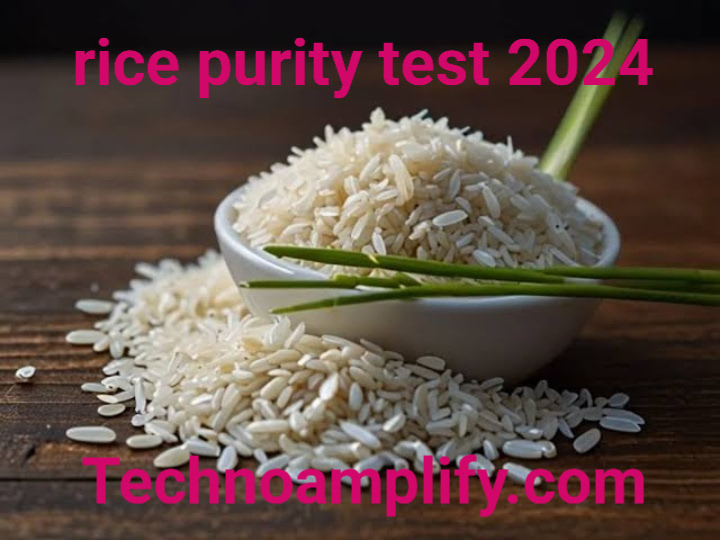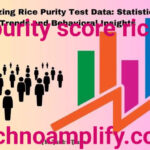Introduction to the Rice Purity Test
The Rice Purity Test is a self-administered questionnaire that asks participants a series of questions related to various experiences, particularly those tied to relationships, behavior, and personal boundaries. The test consists of 100 questions, with each question representing an experience that some may consider to be less conventional or taboo in nature. While the test originally began as a fun way for college students to gauge their “purity,” it has evolved over time to become something much more complex and reflective of contemporary cultural attitudes toward sexuality, identity, and personal growth.
In 2024, the Rice Purity Test remains widely available online, often presented as a playful challenge. Many people take the test for fun, out of curiosity, or as a way to compare experiences with friends or peers. But the questions in the test can evoke deeper reflections about one’s personal values and life choices, and for some, it offers a chance to gain insight into their own experiences and expectations.
Although the test has come under scrutiny over the years for being oversimplified and potentially reinforcing outdated or stigmatized views of purity, it continues to captivate people around the world. As social norms evolve, so too does the Rice Purity Test, adapting to reflect the changing tides of society.
The Origins of the Rice Purity Test: A Historical Overview
The origins of the Rice Purity Test trace back to the late 1980s. The test was first created by students at Rice University, a private institution located in Houston, Texas. Initially, it was designed as a fun and lighthearted way to explore the contrast between “pure” and “impure” experiences, particularly as students navigated their newfound freedom away from home and parental oversight. Over time, the test spread from its college origins to become a cultural touchstone among younger generations, thanks to the internet. With the rise of social media platforms, online forums, and message boards, the test became a viral trend, particularly on platforms like Facebook and Reddit. The test’s format made it ideal for sharing with others, as individuals would often post their results online, comparing scores with friends and acquaintances.

The early 2000s saw the test gain significant traction, and its influence continued to grow with the advent of platforms like Tumblr and Twitter, where the Rice Purity Test was frequently discussed. However, it wasn’t until the rise of TikTok and other short-form content platforms in the late 2010s and early 2020s that the Rice Purity Test reached its modern form. In this era, it became a viral sensation, with millions of people taking the test and sharing their results in creative, often humorous ways.
Despite its growing popularity, the test has been critiqued for perpetuating a narrow and outdated view of “purity” and for encouraging comparison between individuals in ways that can foster unhealthy judgment and self-criticism. Still, the Rice Purity Test has maintained its popularity, with people continuously finding new ways to engage with it and make it relevant to their personal experiences.
The Structure and Format of the Rice Purity Test in 2024
The Rice Purity Test consists of 100 questions, each asking the participant to reflect on specific experiences. The questions are divided into categories such as relationships, sexuality, substance use, and social behavior. For each question, the individual must answer either “Yes” or “No,” based on whether they have experienced or participated in the activity or situation described. The test is often presented as a way of quantifying one’s “purity” or “innocence,” though many people take it with a grain of salt, recognizing it as more of a social game than a serious reflection of personal worth. The results of the test are calculated by the number of “No” answers the person gives, with a higher number of “No” answers generally correlating with a higher purity score.

In 2024, the Rice Purity Test has become increasingly flexible, with versions of the test available in various formats and styles. Some are traditional, with the classic list of 100 questions, while others have been updated to reflect modern issues like mental health, technology use, and cultural shifts. There are also themed versions of the test that focus on specific topics like relationships, social media habits, or career milestones.
For example, some versions of the test in 2024 may include questions about virtual experiences such as online dating, social media interactions, or digital privacy. This reflects the increasing importance of digital and online interactions in shaping modern identity. As a result, the test has become more adaptable, with a wider range of people able to relate to the questions and the experiences they probe.
Cultural Implications of the Rice Purity Test in 2024
The Rice Purity Test has sparked debates over the years about its impact on cultural norms and its potential to reinforce certain stereotypes. One of the main criticisms is that it tends to focus heavily on conventional, often outdated ideas of sexual purity and moral righteousness, which can exclude or marginalize people who have different experiences or values. In 2024, however, there is a growing awareness that the test does not have to be seen through such a narrow lens. Many people use the test as a tool for reflection or self-awareness, without necessarily adhering to any one set of cultural standards. The test is increasingly viewed as a personal journey rather than a strict measure of “purity.”

Additionally, the test’s evolution reflects broader societal shifts, especially regarding issues such as consent, mental health, and gender identity. In recent years, there has been a concerted effort to make the test more inclusive and accessible to people of all backgrounds and experiences. For example, some versions now offer options for individuals who identify outside the binary concept of gender, or who may not feel comfortable with some of the traditional questions.
While the Rice Purity Test continues to be a fun, lighthearted activity for many, it also serves as a reminder of the power of self-perception and the social pressures that shape our understanding of morality and self-worth. As more and more people question the meaning of “purity” in a rapidly changing world, the Rice Purity Test provides a lens through which to explore these evolving values.
The Psychological and Social Impact of the Rice Purity Test
Taking the Rice Purity Test can lead to a range of emotional and psychological responses. For some, it offers a sense of validation and confirmation of their choices, particularly if they score “pure” according to the test’s criteria. For others, it may evoke feelings of guilt, shame, or insecurity, especially if their responses don’t align with societal expectations or the perceived norms of their peer group.

The test’s emphasis on comparing one’s experiences with others can foster a competitive or judgmental atmosphere. It can also inadvertently reinforce harmful ideas about what constitutes a “normal” or “acceptable” life trajectory. Given the highly subjective nature of purity and morality, the Rice Purity Test may sometimes lead to feelings of inadequacy or self-doubt, particularly among younger individuals who may still be navigating their sense of identity and values.
At the same time, the test offers an opportunity for people to reflect on their experiences, values, and life choices in a way that may not otherwise be available. Some people find it to be a useful starting point for self-exploration or even as a conversation starter with friends or romantic partners. Whether or not it should be taken seriously, however, depends on the individual and their perspective.
Conclusion: The Rice Purity Test in 2024 – A Tool for Fun or Reflection?
The Rice Purity Test has remained a cultural phenomenon for over three decades, and in 2024, it continues to captivate people around the world. While its origins may have been lighthearted and rooted in college tradition, the test has evolved into a complex social tool that encourages self-reflection, comparison, and sometimes, cultural commentary.
Despite criticisms of its oversimplified approach to measuring purity, the test remains an engaging and widely shared experience that allows people to assess their own personal journeys. Whether taken for fun, curiosity, or deeper introspection, the Rice Purity Test continues to evolve alongside social and cultural changes, adapting to meet the diverse experiences of its global audience.
As we look ahead to the future, it’s clear that the Rice Purity Test will continue to be a part of the cultural landscape. Whether as a game, a tool for reflection, or a means of social connection, it remains a unique and engaging experience for millions of people worldwide.
FAQs about the Rice Purity Test 2024
1. What is the Rice Purity Test?
The Rice Purity Test is a questionnaire that consists of 100 questions about various life experiences. It is designed to measure a person’s “purity” by asking whether they have participated in certain activities, particularly those related to relationships, behavior, and social conventions.
2. Why is the Rice Purity Test popular?
The test is popular because it offers a fun and lighthearted way for people to compare their experiences with others. It has also gained widespread popularity on social media platforms, where people share their results and engage in friendly comparisons.
3. Is the Rice Purity Test serious?
While the Rice Purity Test is not intended to be taken
Also Read This : The Rice Purity Test 2024: A Deep Dive into the Trending Social Experiment and Its Cultural Significance


